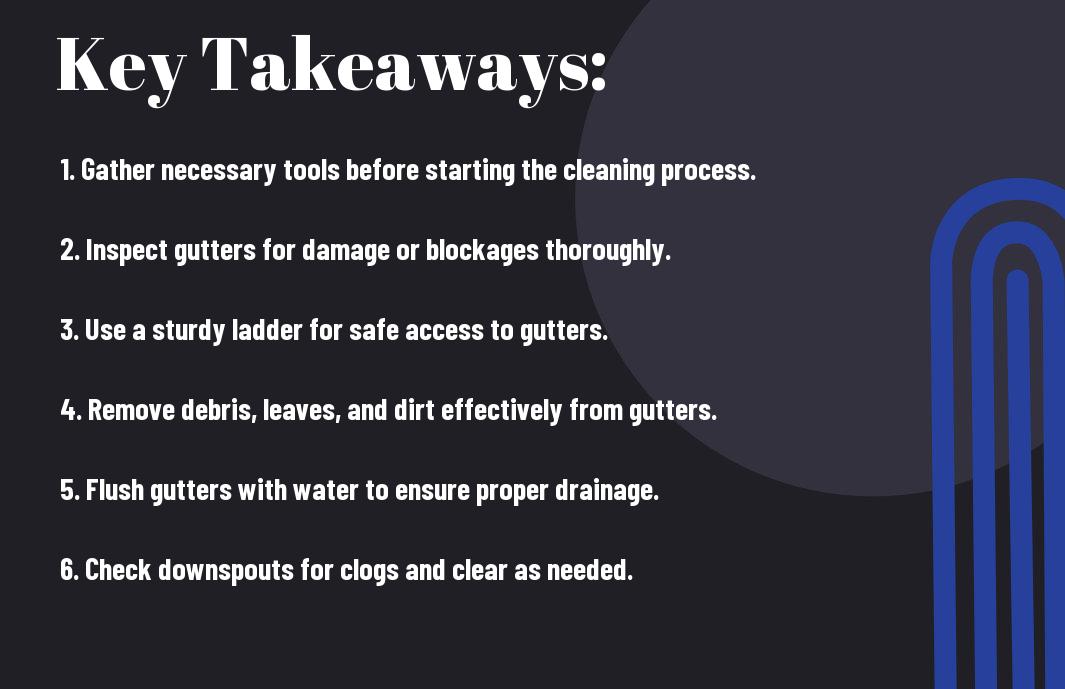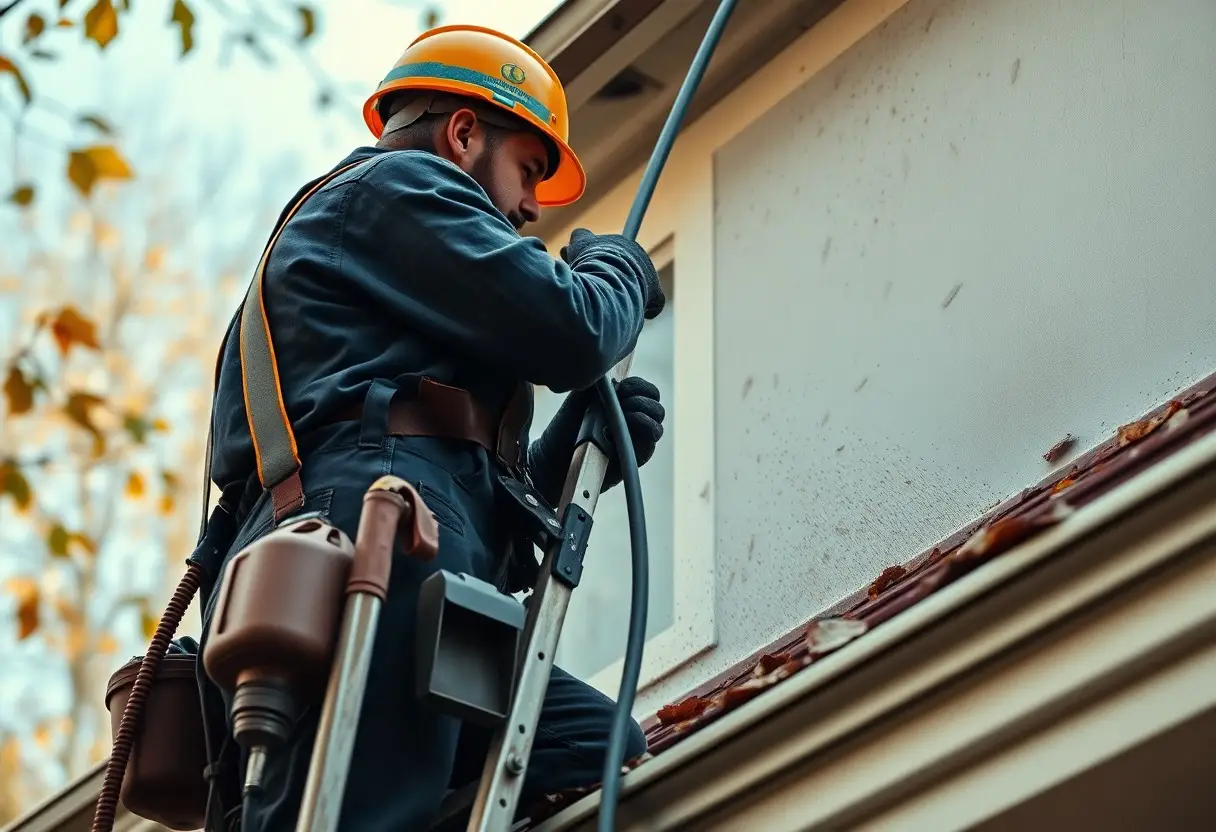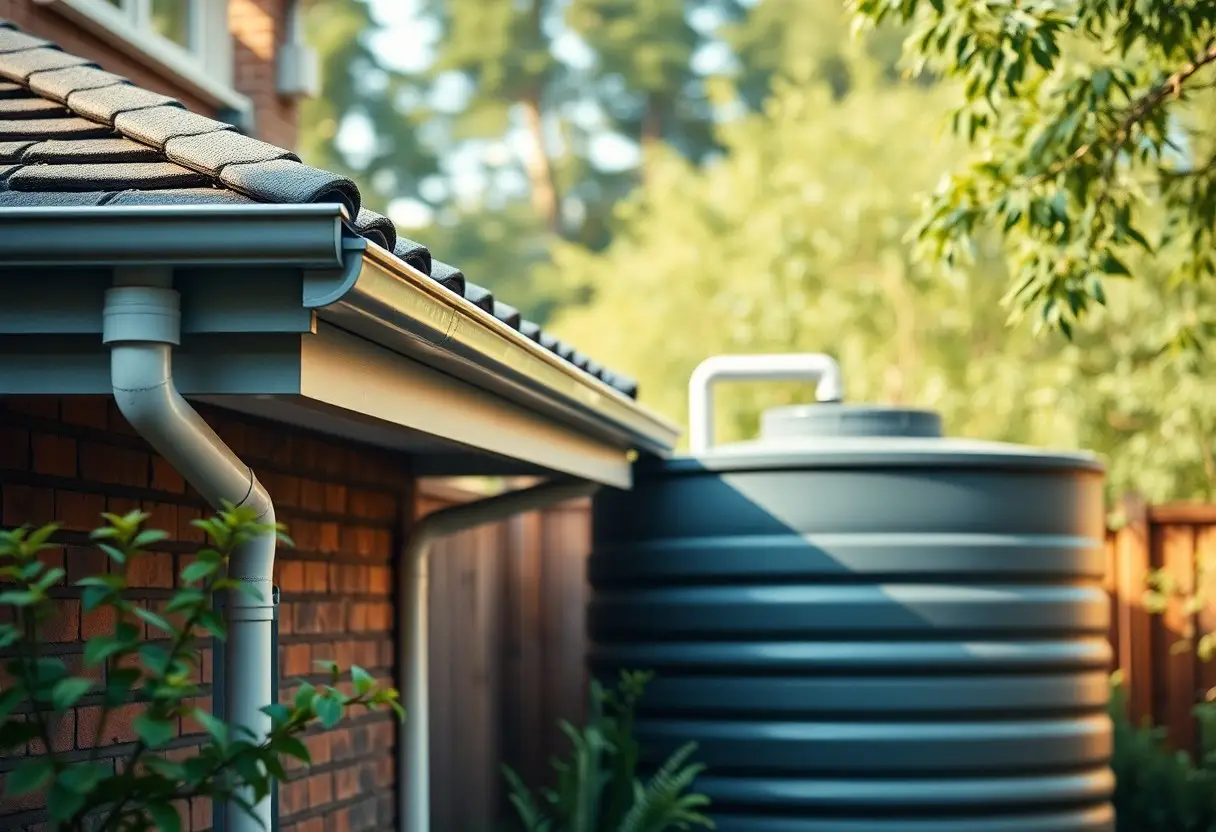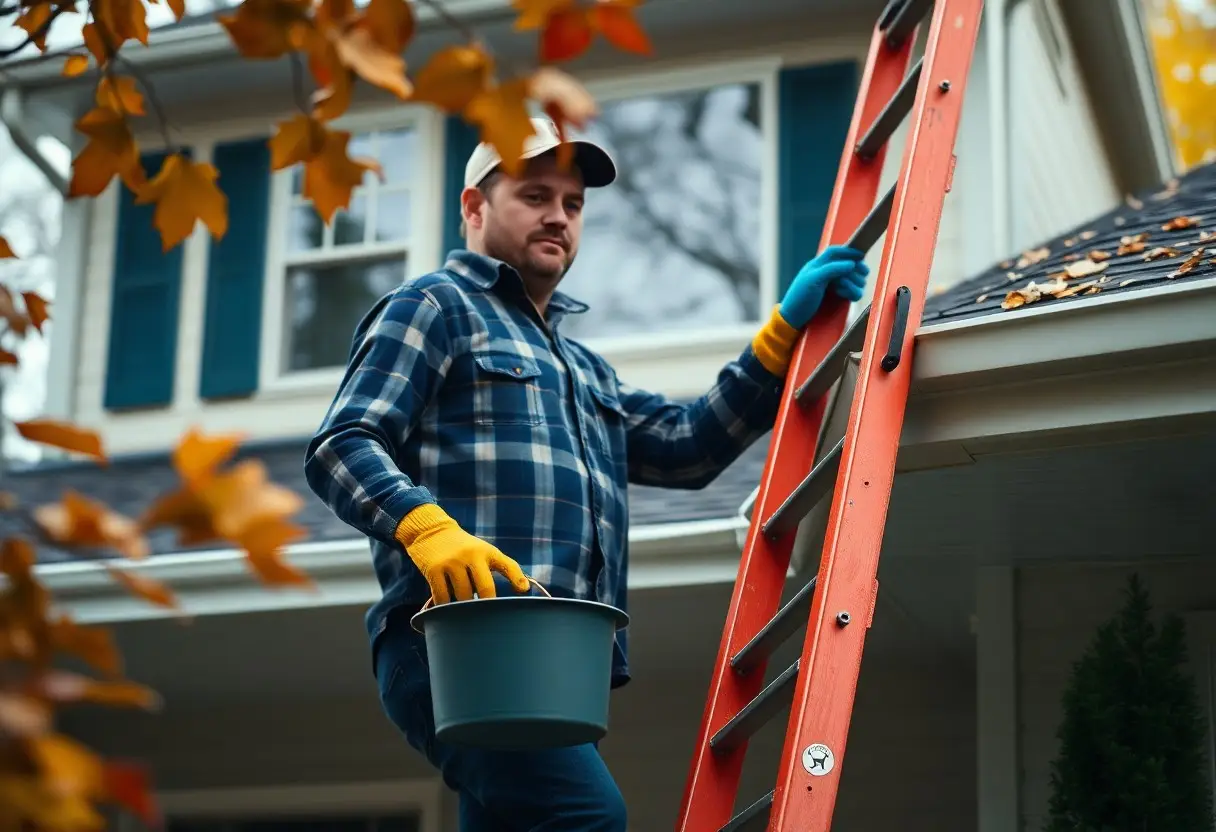Cleaning your gutters is vital for maintaining the health of your home and preventing serious water damage. If neglected, clogged gutters can lead to foundation issues and costly repairs, making regular maintenance a key component of homeownership. This comprehensive checklist will guide you through nine vital steps to achieve sparkling gutters and safeguard your property from erosion, leaks, and mold. Follow these actionable steps to make gutter cleaning a straightforward process that enhances your home’s value and longevity.
Key Takeaways:
- Regular maintenance of gutters helps prevent water damage and costly repairs by ensuring proper water flow and drainage.
- The checklist includes important steps such as safety precautions, debris removal, and inspecting for damage or clogs, ensuring a thorough cleaning process.
- Utilizing the right tools and techniques can enhance efficiency and effectiveness during the gutter cleaning process, leading to long-lasting results.
Why Gutter Cleaning is Important
To maintain the integrity of your home, regular gutter cleaning is imperative. Clogged gutters can lead to numerous issues, including water damage, pest infestations, and even foundation problems. By ensuring your gutters are clear, you protect your property and its value, creating a safer environment and enhancing your home’s longevity.
Preventing Water Damage
Between heavy storms and seasonal rain, clogged gutters can quickly overflow, causing water to seep into your home. This can lead to extensive water damage, including mold growth, rotting wood, and compromised structural integrity. Keeping your gutters clean will help channel water away from your home, safeguarding it from these potential threats.
Extending Gutter Lifespan
Among the many benefits of regular gutter cleaning, one of the most significant is extending the lifespan of your gutters. Debris buildup can cause gutters to sag or detach from your home, leading to expensive repairs or replacements. With proper maintenance, you can avoid these problems and keep your gutters functioning effectively for many years.
Due to the accumulation of leaves, twigs, and dirt, untreated gutters can experience corrosion and premature wear. Regular cleaning not only removes obstructions but also helps you identify signs of damage early on, allowing for timely repairs. By investing time in gutter maintenance, you ensure your gutters remain efficient and protect against costly damage in the future, ultimately saving you money and preserving your home’s structural integrity.

Safety Precautions
You need to prioritize your safety while cleaning gutters to avoid accidents and injuries. Ensure you are aware of your surroundings and follow the necessary protocols to work safely at heights. Taking these precautions keeps you protected and allows you to focus on achieving sparkling clean gutters.
Required Safety Gear
For effective protection during your gutter cleaning tasks, equip yourself with imperative safety gear. Items such as hard hats, non-slip gloves, and safety goggles are vital to shield you from debris and potential hazards.
Ladder Safety Tips
Against all odds, using a ladder safely is key to ensuring a secure gutter cleaning experience. Follow these ladder safety tips to avoid slips and falls:
- Set the ladder on stable, level ground.
- Always use a ladder height appropriate for your cleaning tasks.
- Maintain three points of contact while climbing.
- Position the ladder at a 75-degree angle.
Any mistakes in ladder safety can lead to accidents, so be vigilant and prioritized.
Another imperative tip for ladder safety is to inspect your ladder before every use. Look for any signs of wear or damage, as a faulty ladder can increase the risk of falls. Here are a few measures you should take:
- Check that all hinges and locks are functioning properly.
- Ensure the ladder is clean and free from dirt or oil.
- Never use a ladder during strong winds or inclement weather.
Any oversight in these checks can jeopardize your safety, so always conduct a thorough inspection beforehand.
Tools and Supplies Needed
Many homeowners underestimate the importance of having the right tools and supplies for gutter cleaning. Equipping yourself with the necessary items ensures that the process is not only effective but also safe and efficient. From basic hand tools to specialized cleaning solutions, having everything ready at hand will streamline your cleaning session and help you achieve sparkling gutters without unnecessary hassle.
Essential Tools
One of the basic tools you need for effective gutter cleaning includes a reliable ladder, which allows you to safely reach those elevated areas. You’ll also want gloves to protect your hands from dirt and debris, a trowel or scoop for removing clogs, and a garden hose to flush out any remaining grime. A good pair of safety goggles is also recommended to shield your eyes from any flying debris during the cleaning process.
Cleaning Solutions
Solutions for gutter cleaning can make a significant difference in the outcome of your task. You might choose a simple mixture of water and vinegar for a natural approach or opt for commercial gutter cleaners that target stubborn stains and buildup.
Also, using one part vinegar to three parts water creates a powerful eco-friendly solution. If you encounter especially tough stains or corrosion, consider using a specialized gutter cleaner. These products are designed to effectively break down organic matter and enhance the overall cleanliness of your gutters, ensuring that they function properly for years to come. Always follow the manufacturer’s instructions for safe and effective use.
Step-by-Step Gutter Cleaning Process
Now that you are ready to clean your gutters, following a systematic process will ensure effective results. Here’s a clear checklist to guide you through each step in an efficient manner.
| Step | Action |
| 1 | Inspect the gutters |
| 2 | Remove debris |
| 3 | Flush the gutters |
| 4 | Check downspouts |
| 5 | Repair any damages |
| 6 | Install gutter guards (optional) |
| 7 | Clean the area around gutters |
| 8 | Inspect during changing seasons |
| 9 | Schedule regular maintenance |
Inspecting the Gutters
Inspecting your gutters is the first step in the cleaning process. You should look for any signs of blockages, rust, or physical damage. A thorough inspection helps you determine the level of cleaning required and identify if any repairs are necessary for your system to function properly.
Removing Debris
Any accumulated debris can significantly impair your gutters’ effectiveness. Begin by carefully using a scoop or your hands (wearing gloves) to remove leaves, twigs, and dirt that have built up over time. Make sure to clear out any clogs in the downspouts as well.
Gutters can easily become clogged with various debris, leading to overflow and possible water damage. By removing all visible materials, you not only enhance water flow but also reduce the risk of mosquito breeding and mold growth. Proper removal requires careful attention to your safety; always use stable ladders and wear protection for your hands and eyes.
Flushing the Gutters
Beside removing debris, you should flush your gutters to ensure they are free of any lingering dirt. Using a garden hose, run water through the gutters and watch for any issues such as slow drainage or leaks.
Plus, flushing your gutters is important as it exposes hidden blockages that manual cleaning might miss. By running a consistent stream of water, you can identify areas that require immediate attention or repairs, ensuring your gutter system works effectively for the upcoming weather changes. A clean, functioning gutter system protects your home from potential water damage and costly repairs.

Checking Downspouts
After cleaning your gutters, the next important step is to check the downspouts. Ensuring these components are functioning properly is vital for preventing water overflow, which can lead to damage to your home’s foundation and landscaping. Start by inspecting each downspout for any visible debris and make sure the water can flow easily through them.
Ensuring Proper Flow
Above all, ensure that your downspouts direct water away from your home’s foundation. This can help prevent water pooling around your base, which may result in serious structural issues over time. Adequate slope is vital for achieving optimal drainage.
Clearing Blockages
Clearing any blockages in the downspouts is necessary for maintaining proper drainage. Use a plumber’s snake or a high-pressure hose if you encounter stubborn clogs, as these tools can help push through debris that may have built up over time.
Due to the potential for serious damage caused by water obstruction, addressing clogs in your downspouts without delay is vital. Obstructed downspouts can lead to serious issues such as flooding in your basement or landscape erosion. Regularly clearing out leaves, dirt, and other debris will not only keep your downspouts functioning well but also protect your home from these dangerous consequences. Make this a part of your maintenance routine to ensure a healthy gutter system.
Maintenance Tips
For optimal gutter performance, implementing a few maintenance tips can make a significant difference:
- Regularly inspect your gutters for debris
- Check for any signs of damage
- Ensure downspouts are free of clogs
- Trim overhanging branches to mitigate future clogs
- Install gutter guards for long-term protection
Recognizing the importance of consistent upkeep will keep your gutters efficient and extend their lifespan.
Frequency of Cleaning
At a minimum, you should clean your gutters at least twice a year, ideally in spring and fall. This frequency ensures your gutters are patently clear, preventing any water damage or overflow.
Seasonal Considerations
Around peak seasons, such as during heavy rainfall or when leaves are falling, your gutters are likely to accumulate debris more quickly. Additionally, late summer storms can deposit extra twigs and leaves, increasing the need for proactive cleaning. Addressing these seasonal fluctuations can save you from major repairs down the line.
Plus, you should pay attention to the effects of winter weather on your gutters. Snow and ice can cause them to become weighed down, leading to potential damage. Also, consider removing icicles or ice dams that can trap water and cause backups. By integrating these seasonal considerations into your gutter maintenance routine, you significantly enhance your home’s defense against water damage and ensure your gutters remain functional year-round.
What Additional Steps Can Be Added to the Gutter Cleaning Checklist for a More Thorough Job?
To enhance your gutter cleaning experience, consider adding some essential gutter cleaning steps explained in detail. Inspect for blockages beyond the obvious, check downspouts for clogs, and use a pressure washer for stubborn debris. Completing these steps ensures your gutters function effectively and prevent water damage to your home.
Final Words
On the whole, following this gutter cleaning checklist will help you maintain sparkling gutters and protect your home from water damage. By systematically executing each of the nine steps, you ensure that debris is cleared, drainage is effective, and your gutters remain in good condition. Regular maintenance not only enhances curb appeal but also extends the lifespan of your drainage system. Take the time to care for your gutters, and you will reap the benefits in protecting your property and avoiding costly repairs down the line.
FAQ
Q: What materials do I need to complete the gutter cleaning process?
A: To effectively clean your gutters, you will need several important materials: a sturdy ladder, gloves to protect your hands, a trowel or scoop for removing debris, a bucket or bag for collecting waste, a hose with a spray nozzle to flush out remaining dirt, and safety goggles to shield your eyes. Additionally, if you have larger debris issues, you may want a leaf blower, and for high gutters, consider a gutter cleaning wand that attaches to your hose.
Q: How often should I clean my gutters to maintain their effectiveness?
A: The frequency of gutter cleaning can vary based on your location and environmental factors. Generally, it is advisable to clean your gutters at least twice a year – once in the spring and once in the fall. If your home is surrounded by trees, you might need to clean them more often, particularly in the fall when leaves are prone to accumulate. Heavy rains and nearby construction can also necessitate more frequent cleanings.
Q: What signs indicate that my gutters might need cleaning or maintenance?
A: There are several signs that may suggest your gutters require cleaning or maintenance. Look for water overflow during heavy rains, as this could indicate blockages. Additionally, check for sagging or leaning gutters, which may signal that they are weighed down by debris. If you notice stains on your home’s exterior or on the ground below your gutters, this might indicate ineffective water drainage. Lastly, the presence of plants or seedlings growing in the gutters is a clear sign that cleaning is needed.


